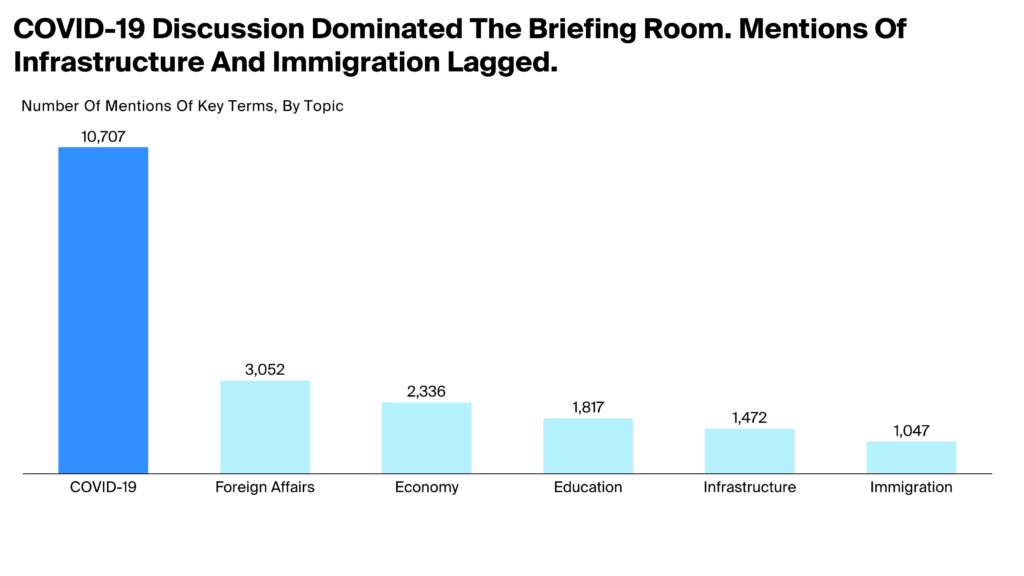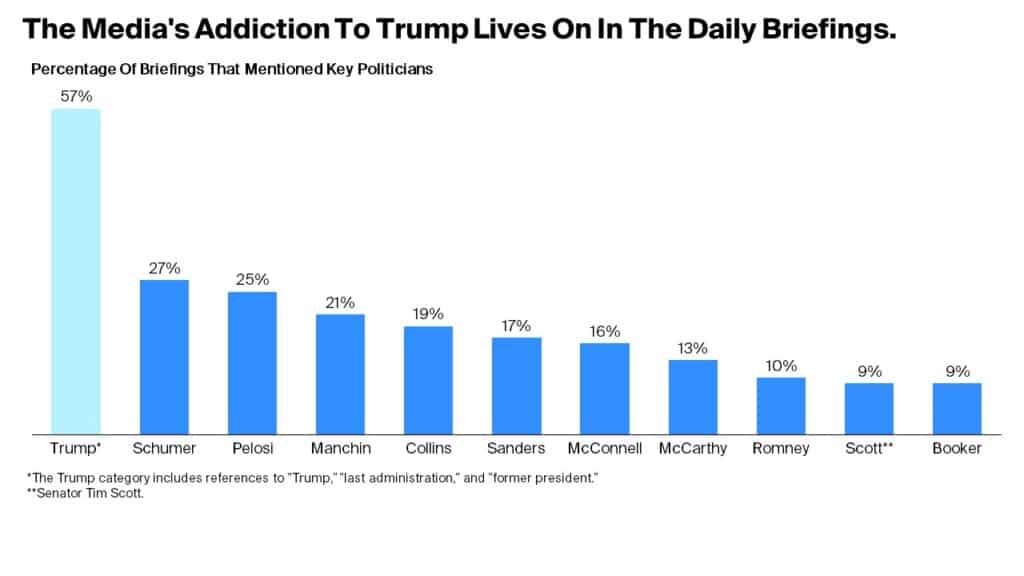Briefings Are Back: An Analytical Look At What Was Discussed In The First Six Months Of White House Press Briefings
When President Biden took office in January, he brought with him the return of the White House press briefings. Prior to January 2020, the briefing room lay empty for nearly two years after former President Trump ended the daily briefings in March 2019. Even before he ended the briefings altogether, Trump held less than half as many as prior administrations.
The return of the daily briefing offered the media and general public insight into the Biden administration’s agenda and priorities, as well as a degree of accountability on the president’s campaign promises and the American people’s priorities for the new administration.
HPS set out to analyze the first six months of press briefings, reviewing transcripts of 160 White House briefings and press gaggles by Press Secretary Jen Psaki, Deputy Press Secretary Karine Jean-Pierre, and the White House COVID-19 Response Team. Our analysis found that their discussions with White House reporters during the first six months of the administration broadly aligned with the public’s priorities.

Unsurprisingly, discussion of COVID-19 dominated the daily briefings, with more than three times as many mentions as the next-most popular topic, foreign affairs (broadly capturing discussion on China, Russia, Afghanistan, and other global issues). Washington was buzzing with infrastructure talk all spring and summer as the Biden administration prioritized passing a bipartisan infrastructure package; however, infrastructure mentions lagged in the administration’s formal briefing room platform at just under 1,500 mentions. Likewise, there were relatively few immigration mentions, despite immigration ranking as the third-most important issue to Americans in a June survey and the ongoing crisis at the U.S.-Mexico border.

The majority of COVID-19 related mentions were associated with vaccines. On March 11, 2021, the Biden administration announced that all American adults would be eligible to receive a COVID-19 vaccine by May 1. Accordingly, briefings and press questions on vaccines peaked in March and April and seemed to plateau by June. In early July, Biden took the stage to announce that about 70% of American adults had been vaccinated. But not long after signaling America was close to “declaring our independence” from COVID-19, the Delta variant took the nation by storm. Although our analysis only goes through July 20—the six-month mark for Biden’s presidency—HPS and any casual observer of the White House press briefings can safely assume there has been a spike in mentions of vaccines in the last month.

While the COVID-19 pandemic topped overall mentions, the Department of Health & Human Services lagged in briefing room discussions. The second-most discussed topic was foreign affairs—which naturally encompasses both diplomatic and military-related issues. Notably, mentions of the State Department far outweighed mentions of the Department of Defense, indicating Biden to be a “diplomacy over aggression” president.

In the briefing room, mentions of jobs far eclipsed all other economic terms. Jobs consistently garnered more than double the number of mentions of other economic terms, peaking in April when the March jobs numbers released showed the fastest growth since August 2020. As tracked by HPS’ monthly Jobs Day Fact Sheets, June posted similar numbers to March, but at that point, the economic recovery was steadily progressing, and the surge in employment didn’t lead to another spike in jobs mentions.

Biden took office as the most experienced president in matters of foreign policy in at least 30 years. When Biden was inaugurated, the top foreign policy questions he faced revolved around how the U.S. would counter China’s growing power and how he might alter the U.S. relationship with Russia following years of investigations and allegations of serious transgressions during the Trump administration. As expected, Russia and China dominated foreign affairs discussions during the press briefings.

However, as with any administration, other foreign policy issues quickly arose and demanded imminent attention. Mentions of Iran in the briefing room peaked in February, when Iran rejected an offer to negotiate directly with the U.S. regarding the nuclear deal, and have tailed off ever since. Mentions of Israel/Palestine jumped dramatically in May during the crisis in Gaza.
Afghanistan mentions initially spiked after the Biden administration announced on April 13, 2021 that the U.S. would complete its withdrawal of forces from the country by September 11. Afghanistan then seemed to fall off the press briefing radar in May before returning to prominence in June and July. While the graph reflects data only through July 20, HPS expects press briefing discussion of Afghanistan to have surged in late July and August—with mentions likely continuing to remain high into the fall.

After both the Senate and presidency flipped this year, Beltway chatter has focused on Democratic policy priorities including voting rights, police reform, and climate change. However, these terms didn’t break through in the briefing room as much as others, registering in just one in four or one in five briefings. Antitrust issues also received few mentions, at just 12 over the course of six months, despite Congressional focus on antitrust in the tech sector. Also surprising was the lack of discussion on student debt or student loans, which received just 16 total mentions.

Despite the Biden administration’s determination to start a new chapter, the media’s addiction to Trump was hard to curb after four years of obsessing over the former president’s every tweet and comment. Trump was mentioned in over half of the briefings, more than twice as frequently as any other politician. The politicians who were referenced in the most briefings following Trump were Senate Majority Leader Chuck Schumer (D-NY), Speaker Nancy Pelosi (D-CA), Senator Joe Manchin (D-WV), and Senator Susan Collins (R-ME).
Senator Elizabeth Warren (D-MA), a champion for progressives and frequent participant in Senate debates, was mentioned in only 4% of briefings. Likewise, Senator Krysten Sinema (D-AZ) was mentioned in just 4% of briefings, despite becoming a prominent voice in recent rounds of infrastructure discussions.
The Next Six Months
Looking forward, HPS expects COVID-19 and foreign affairs to remain the top two topics in the briefing room, with mentions of vaccines dominating the former and Afghanistan driving the latter. We expect the economy to remain a top-three category, especially as the infrastructure, budget, and debt-ceiling debates heat up this fall.
Methodology
HPS conducted text analysis on hundreds of hand-selected key terms within 160 White House briefings (including press briefings in the White House briefing room, press gaggles aboard Air Force One, and briefings by the COVID-19 Response Team) from January 21, 2021 to July 20, 2021.